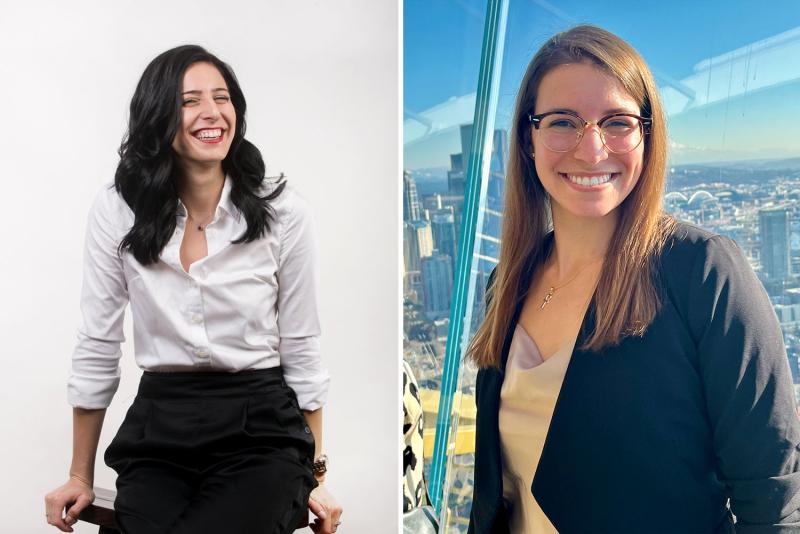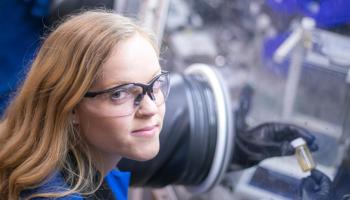Chemists’ Device Could Be a Gamechanger for Crime Scene Investigators

Since its introduction in the 1980s, DNA profiling has revolutionized the criminal-justice system, providing law enforcement officials with powerful evidence linking suspects to crime scenes or helping identify their victims, but the science has its limits. DNA samples collected from crime scenes and human remains still need to be compared with reference samples or genetic profiles already included in criminal databases to provide a match, and backlogs in DNA testing mean that violent criminals are walking the streets while the evidence needed to convict them sits on a laboratory shelf. However, new research conducted by two graduate students with the University of Virginia’s College and Graduate School of Arts & Sciences, could help bring both problems nearer to a solution.
As a forensic chemist and DNA analyst for a Maryland Police Department, Rachelle Turiello, was confronted with a challenge. One of the detectives she worked with had located human bones at a crime scene, but the department’s lab wasn’t equipped to analyze bone samples. Additionally, DNA the detective had collected matched nothing in the Combined DNA Index System, or CODIS, the national DNA database created and maintained by the FBI, leaving them with few clues to advance their investigation. Only after sending the samples off to a lab at the University of North Texas with more advanced capabilities were the detectives able to add more information to the victim’s profile, including hair, skin and eye color as well as more detail about the victim’s ancestry, but they were still missing key pieces of information like the victim’s age.
“I just thought there’s got to be more that we can do,” said Turiello, who knew that the science for predicting age using DNA samples already existed. “That was the moment I decided to go to graduate school.”
After meeting James Landers, a professor in the College’s Department of Chemistry as well as the University’s mechanical engineering and pathology departments who leads the Landers Bioanalytical Microfluidics Lab at UVA, at a conference on forensic science, Turiello applied to the College’s Department of Chemistry as a doctoral candidate.
With a background in crime-scene investigation that draws on her interdisciplinary education in anthropology and forensic genetics, Turiello was attracted by the Lab’s focus on applying analytical methods to real-world problems and its interdisciplinary approach to building devices and instrumentation that have chemical and biological applications.
“I love anything that pulls from different disciplines and works hard to solve a problem,” Turiello said.
The Lab is also where she met her business partner, Renna Nouwairi, another graduate student working toward the same degree.
A native of Virginia, Nouwairi studied chemistry and mathematics as an undergraduate and taught chemistry, physics and robotics at a private school in Staunton after graduation. She had known since high school that she wanted to go to graduate school, and after seeing the work students in the Landers Lab were doing, she knew where she had to be.
“I was really impressed with the application-driven nature of the work and its interdisciplinary aspect. We obviously do chemistry, and we do a lot of biology as well,” Nouwairi said, “We have to understand the physics that happens at the microfluidic scale, and then in building a lot of these devices and the instrumentation for the devices we make, we get to learn engineering and even some software coding.”
The mutual interest Turiello and Nouwairi have in developing practical solutions to common problems led to a research partnership that has already begun to pay off. Together, they have built a device that looks much like a standard CD made of multiple layers that contain the chemicals and miniature instrumentation necessary to fully automate the testing of DNA samples for the prediction of human age. The device makes this kind of testing easier, faster and less expensive, and more sensitive than conventional methods. The device can also be used with minimal training, making advances like DNA testing available to police departments that don’t have the expertise or the laboratory services available to make use of them. The platform the system operates within is unique to the Landers Laboratory and was previously built to automate complete genetic analysis for human identification. Turiello and Nouwairi feel that this system can be adapted to use in other fields like healthcare, where it could be used to make early cancer detection faster and easier.
The biggest problem they’ve faced in developing their DNA testing device, however, has been knowing what to do with their prototype.
“Our biggest challenge has been in bringing it out there into the world,” Turiello said. “There’s no formal path for commercialization.”
Turiello feels that the College’s Department of Chemistry does a good job of preparing its students for careers outside of academia, but the training needed to translate academic research into something that can be manufactured and marketed on a large scale is outside of the scope of a graduate degree in the sciences. However, an internship opportunity with the University’s Licensing & Ventures Group, a nonprofit foundation that works with faculty, staff and students on issues related to patenting, licensing and developing new business ventures, gave the pair the help they needed to begin to explore the commercial potential of their invention.
In partnership with the University’s PhD Plus program, a University-wide initiative to prepare Ph.D. students and postdoctoral scholars for long-term career success, Licensing & Ventures offers clinics and workshops to help graduate students understand the commercialization process. When Turiello and Nouwairi received an email from Licensing & Ventures about an internship that would teach them how to pitch ideas to industry, they signed up immediately.
“It was incredibly enlightening to see not only all of the technology that’s happening at UVA but also to see how that technology is being presented to business and licensing partners and to see some of the great success stories of companies that commercialized a great product, some of which are now operating incredible businesses in Charlottesville,” Nouwairi said.
With the experience and the connections they’ve made, Turiello and Nouwairi are now focused on the prospect of staying in Charlottesville and founding a start-up of their own. But Turiello admits that there are still a number of challenges they’ll need to face. She and Nouwari recently published a paper about the use of microfluidic devices in the forensic marketplace and how difficult it can be to commercialize new inventions.
“There are so many customers, and they all want different things, and from the legal perspective, the evidence they provide needs to be admissible in court. They need to be tried and true and so thoroughly tested that they are irrefutably perfect,” Turiello said. “On the other hand, science and forensics need to be constantly moving forward, taking advantage of new technology and new tools for data analysis, but I think what we’ve developed is a really beautiful solution to some of the problems forensic investigators face.”
“Researchers like Renna and Rachelle often have a fresh and innovative perspective on the research they are pursuing and are not constrained by the traditional ways of thinking in their field and approaches to commercialization. This can lead to breakthrough discoveries and advancements that have the potential to revolutionize their field,” said Nikki Hastings, co-founder and executive director of CvilleBioHub, a nonprofit that works closely with UVA’s Licensing & Ventures Group and supports the growth of the regional biotech industry in Central Virginia.
“Rachelle’s impact on my lab has been huge,” said James Landers, Commonwealth Professor in chemistry, mechanical engineering and pathology. “I’m not trained as a forensic scientist, but we have technology in our lab that’s very applicable to forensic science, and what Rachelle brings to the lab is the perspective of someone who has been in the trenches, and that’s something you can’t get from a textbook. She’s a great resource in terms of critiquing our pursuit of applications that aren’t really meeting the need of the forensics community, and she’s been very good at saying ‘Here’s a major unmet need in the forensics world. This is something we should consider going after.’”
“Rachelle and Renna are extraordinary,” Landers added. “That goes without saying. They’re poised uniquely for success.”
We’re here to answer your questions! Contact us today.








